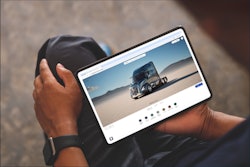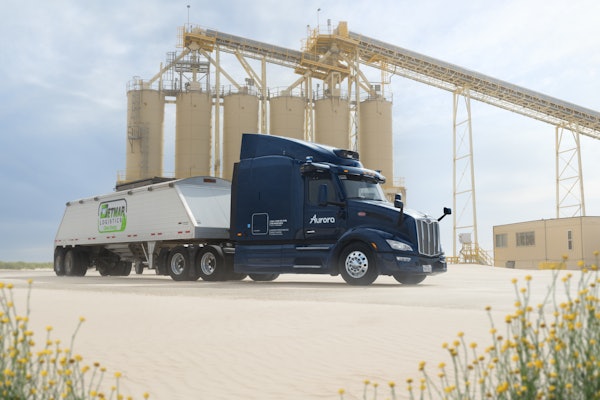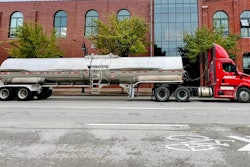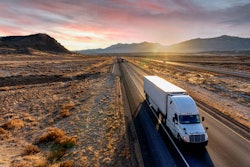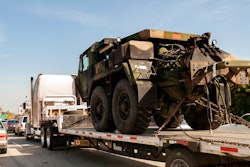When snow is blowing in over the upper Midwest or there’s ice on the roads in Oklahoma in the middle of January, Matt Fengler, operations supervisor for K&B Transportation, and other staff members spend the majority of their day on state websites, checking road cameras and looking at radar to keep a pulse on weather to determine if their drivers need to reroute, shut down or push through.
According to the Federal Highway Administration, 21% of all vehicle crashes in the U.S. annually are weather-related. Weather is the reason for 3% of those involving large trucks, according to a Federal Motor Carrier Safety Administration (FMCSA).
K&B has experienced the negative effects of weather, and being a perishable food products transporter, the company needed to take action. It has seen an 80% reduction in DOT recordable accidents and about the same decrease in insurance claims for weather-related accidents, since customizing communications within its driver app to relay weather-related safety risks to drivers.
Those weather-related alerts to drivers, though, are still based on Fengler and his team’s weather-monitoring skills and abilities.
Scott Pecoriello, founder and CEO of weather analytics company WeatherOptics, said that’s the case for most fleets, but more are discovering solutions like his to not only identify weather when it’s happening but predict it and prevent related accidents.
“There has been a lot of changes, especially over the last couple of years, and from our perspective, I think it's a lot more about getting more predictive with weather data,” Pecoriello said. “In the past, there has been a reactionary stance on weather. Like, ‘we'll watch the radar. We'll watch as the weather unfolds, and then we'll manually alert drivers about issues.’”
He said many fleets over the past two years have learned more about AI-based weather prediction and have begun to implement those services within their operations to help favorably manage downtime, support customer service and improve safety.
Using AI in weather
WeatherOptics integrates with ELDs and uses AI to predict when a driver is going to be in place that intersects with a severe weather event. The service can inform a trucking company days in advance that it is going to be impacted by weather and offer an alternative routing option.
The company offers a risk score based on a driver’s location and their susceptibility to weather in that location.
“Our software picks up on how used to conditions these drivers are,” Pecoriello said. “We're training our data based off of historical incident information. So we know Birmingham drivers are not as good in rainy conditions or snowy conditions. If you're up in Minnesota or Chicago, sometimes these guys are driving in 6, 7, 8 inches of snow and not having issues.”
He said WeatherOptics uses AI to make its weather forecasts more accurate by training its data on historical weather events. The AI also adjusts forecast outputs.
“Every one to two minutes, if something changes, our machine learning is bias correcting those forecasts so that we're actually becoming a more accurate weather service,” he said. “At the end of the day, we're seeing a 30% to 40% reduction in weather forecast errors using the model that we've developed in house.”
The company’s second AI use case is ingesting trucking incident and delay data and training its models from that data, which has been collected from over 40 million connected vehicles over 15 years.
“If a driver gets into an incident or accident, our model is using that to then say, ‘hey, we think these conditions are going to happen again in two days.’”
Other weather solutions, like Samsara, uses AI in a different way.
Samsara’s weather intelligence solution, which rolled out this summer, overlays real-time weather data pulled from the National Weather Service onto existing maps on Samsara dashboards so trucking companies can view where their trucks are on the map in relation to weather.
Samsara uses AI to deliver weather alerts to drivers. It also uses AI to extract data, and edge AI runs to process weather conditions.
“If you're following too closely to the vehicle in front of you in low visibility situations, that would also be AI-detected,” said Johan Land, senior vice president of product and engineering for safety and AI at Samsara.
The solution provides video footage of weather on the ground via its AI dash cameras. Samsara uses that footage from vehicles across the entirety of its network to inform fleets independently of weather conditions.
Land said it also helps when it comes to driver coaching because the system can identify context around driver behavior like a rolling stop when its icy versus a rolling stop when roads are completely dry. That helps fleets understand when training is actually necessary. The AI is used to summarize trips and identify if a driver needs coaching after the fact based on their behavior during a weather event.
Other weather technologies
Like Samsara, K&B Transportation uses its driver app, created by Eleos, to send drivers weather alerts. But the company has taken things a step farther and recently began using speed management solution eSmart to limit truck speed.
While its use of that isn’t purely for weather purposes – also based on speed limits, road conditions, construction zones and state-issued speed enforcement programs in certain areas – the company has been working with eSmart to integrate weather.
For example, if it’s beginning to snow in Iowa, and the company doesn’t want its trucks running the listed speed limit of 65, it will set the truck’s limit to 55 by affecting the throttle position sensor. Then the driver will be alerted via the Eleos app.
[RELATED: Drivewyze launches severe weather alerts on Safety+ platform]
That’s just one more way weather technology for fleets has changed recently, and it continues to evolve as industry experts like Land continue to study weather and how it impacts driver behavior.
“My team and I wake up every morning and ask ourselves, ‘How can we prevent more accidents?’ Then we study the accidents, and that's why weather comes up so high on the priority list,” he said.
He noted one theme is lack of preparedness.
“You need to be prepared for weather. If you just randomly drive into weather you don't know, or if you have a driver that doesn't have the experience of it and drives into weather, that's when things go bad,” Land added. “If you know about it, you're prepared, and you're taking precautions and adjusting your driving, then the risk goes down drastically.”


